Physical Address
304 North Cardinal St.
Dorchester Center, MA 02124
Endometriosis is a benign, usually progressive, and sometimes recurrent disease that invades locally and disseminates widely. Causes include retrograde menstruation, coelomic metaplasia, vascular metastasis, immunologic changes, iatrogenic dissemination, and a genetic predisposition.
Endometriosis lesions produce estrogen locally and have increased secretion of prostaglandins and inflammatory cytokines, which can cause pain and contribute to infertility. There is also a relative resistance to progesterone in endometriosis lesions.
There are several established treatments for endometriosis (such as oral contraceptives, gonadotropin-releasing hormone [GnRH] agonists, and danazol) and some novel therapies undergoing trials such as the use of oral antagonists, aromatase inhibitors, progesterone receptor modulators, and cytokine inhibitors. The recurrence rate after medical therapy is 5% to 15% in the first year and increases to 40% to 50% in 5 years.
The recurrence rate after medical therapy is 5% to 15% in the first year and increases to 40% to 50% in 5 years.
The incidence of endometriosis is 30% to 45% in women with infertility. There is probably some benefit to ablating endometriosis lesions when seen at laparoscopy. In patients with endometriosis, the success of in vitro fertilization–embryo transfer (IVF-ET) decreases only in women with severe disease.
Endometriosis is a benign, usually progressive, and sometimes recurrent disease that invades locally and disseminates widely. Causes include retrograde menstruation, coelomic metaplasia, vascular metastasis, immunologic changes, iatrogenic dissemination, and genetic predisposition.
Endometriosis lesions produce estrogen locally and have increased secretion of prostaglandins and inflammatory cytokines, which can cause pain and contribute to infertility. Endometriosis lesions also have a relative resistance to progesterone.
There are several established treatments for endometriosis (such as oral contraceptives and gonadotropin-releasing hormone agonists and danazol) and some novel therapies undergoing trials, such as the use of oral antagonists, aromatase inhibitors, progesterone receptor modulators, and cytokine inhibitors. The recurrence rate after medical therapy is 5% to 15% in the first year, increasing to 40% to 50% in 5 years.
The recurrence rate after medical therapy is 5% to 15% in the first year, increasing to 40% to 50% in 5 years.
The incidence of endometriosis is 30% to 45% in women with infertility. There is probably some benefit to ablating endometriosis lesions when seen at laparoscopy. In patients with endometriosis, the success of IVF-ET decreases only in women with severe disease.
Endometriosis is a benign but, in many women, progressive and aggressive disease, with a major impact on the quality of women’s lives and creating a significant economic burden of billions of dollars. The wide spectrum of clinical problems that occur with endometriosis has frustrated gynecologists, fascinated pathologists, and burdened patients for years. Although endometriosis was first described in 1860, the classic studies by Sampson in the 1920s were the first to emphasize the clinical and pathologic correlations of endometriosis ( ). Even today, many aspects of the disease remain enigmatic.
By definition, endometriosis is the presence and growth of the glands and stroma of the lining of the uterus in an aberrant or heterotopic location. Adenomyosis is the growth of endometrial glands and stroma into the uterine myometrium to a depth of at least 2.5 mm from the basalis layer of the endometrium. Adenomyosis is sometimes termed internal endometriosis; however, this is a semantic misnomer because most likely they are separate diseases.
It is often stated that the incidence of endometriosis has been increasing, but this is likely secondary to an enlightened awareness of mild endometriosis as diagnosed by the increasing use of laparoscopy. Delay in making the diagnosis is common; it has been estimated to take an average time of 11.7 years in the United States and 8 years in the United Kingdom to make the diagnosis. Evers has advanced a provocative hypothesis that endometrial implants in the peritoneal cavity are a physiologic finding secondary to retrograde menstruation, and their presence does not confirm a disease process ( ). The overall prevalence of endometriosis in reproductive-age women has been suggested to be as high as 11% ( ). The age-specific incidence or prevalence of endometriosis is not known and has only been estimated. Many patients are diagnosed incidentally during surgery performed for a variety of other indications. Conservative estimates find that endometriosis is present in 5% to 15% of laparotomies performed on reproductive-age female patients. Active endometriosis may be found in approximately three-quarters of women with chronic pelvic pain and in 30% to 45% of women with subfertility . In subfertile women the diagnosis is not commonly made because diagnostic laparoscopy is rarely carried out. In a compilation of eight studies encompassing 162 patients with endometriosis, the natural course of endometriosis was reported to increase or progress in 31% of cases , to remain the same in 32%, and to regress in 38%.
The cause of endometriosis is uncertain and involves many mechanisms including retrograde menstruation, vascular dissemination, metaplasia, genetic predisposition, immunologic changes, and hormonal influences, as discussed later. In addition, there is increasing evidence that environmental factors may also play a role, including exposure to dioxin and other endocrine disruptors. Clinically it is most difficult to predict the natural course of endometriosis in any one individual.
The classic symptom of endometriosis is pelvic pain. However, in clinical practice the majority of cases are not “classic.” The diagnosis and treatment of infertility associated with endometriosis is discussed in Chapter 40 . Aberrant endometrial tissue grows under the cyclic influence of ovarian hormones and is particularly estrogen dependent; therefore the disease is most commonly found during the reproductive years. However, 5% of women with endometriosis are diagnosed after menopause. Postmenopausal endometriosis is usually stimulated by exogenous estrogen. Teenagers with endometriosis should be investigated for obstructive reproductive tract abnormalities that increase the amount of retrograde menstruation. Although previously thought to be rare in adolescents, endometriosis has been found in approximately half of teens with pelvic pain.
Endometriosis is a disease not only of great individual variability but also of contrasting pathophysiologic processes. There is an inverse relationship between the extent of pelvic endometriosis and the severity of pelvic pain . Women with extensive endometriosis may be asymptomatic, whereas other patients with minimal implants may have incapacitating chronic pelvic pain. However, as would be expected, women with deep infiltrating endometriosis (DIE), especially in retroperitoneal spaces, often experience severe episodes of pain. Pelvic lesions of endometriosis have been found to have positive immune staining for smooth muscle and nerve cells ( ). The clinical variability in responses among women with endometriosis may relate to differences in immunologic function and variations in cytokine production.
Several theories have been posited to explain the pathogenesis of endometriosis, but no single theory adequately explains all the manifestations of the disease. Most important, there is only speculation as to why some women develop endometriosis and others do not. One popular theory is that there is a complex interplay between a dose-response curve of the amount of retrograde menstruation and an individual woman’s immunologic response (these in turn may depend on ethnic and genetic variability).
The most popular theory is that endometriosis results from retrograde menstruation. Sampson suggested that pelvic endometriosis was secondary to implantation of endometrial cells shed during menstruation ( ). It has been suggested that the shedding of endometrial-based adult stem cells and mesenchymal cells may explain this phenomenon ( ). These cells attach to the pelvic peritoneum and under hormonal influence grow as homologous grafts. Indeed, reflux of menstrual blood and viable endometrial cells in the pelvis of ovulating women has been documented. Endometriosis is discovered most often in areas immediately adjacent to the tubal ostia or in the dependent areas of the pelvis.
Endometriosis is commonly found in women with outflow obstruction of the genital tract. The attachment of the shed endometrial cells involves the expression of adhesion molecules and their receptors. This is thought to be an extremely rapid process as demonstrated in vitro. Figs. 19.1 and 19.2 depict the process of implants from retrograde menstruation and early invasion ( ; ).
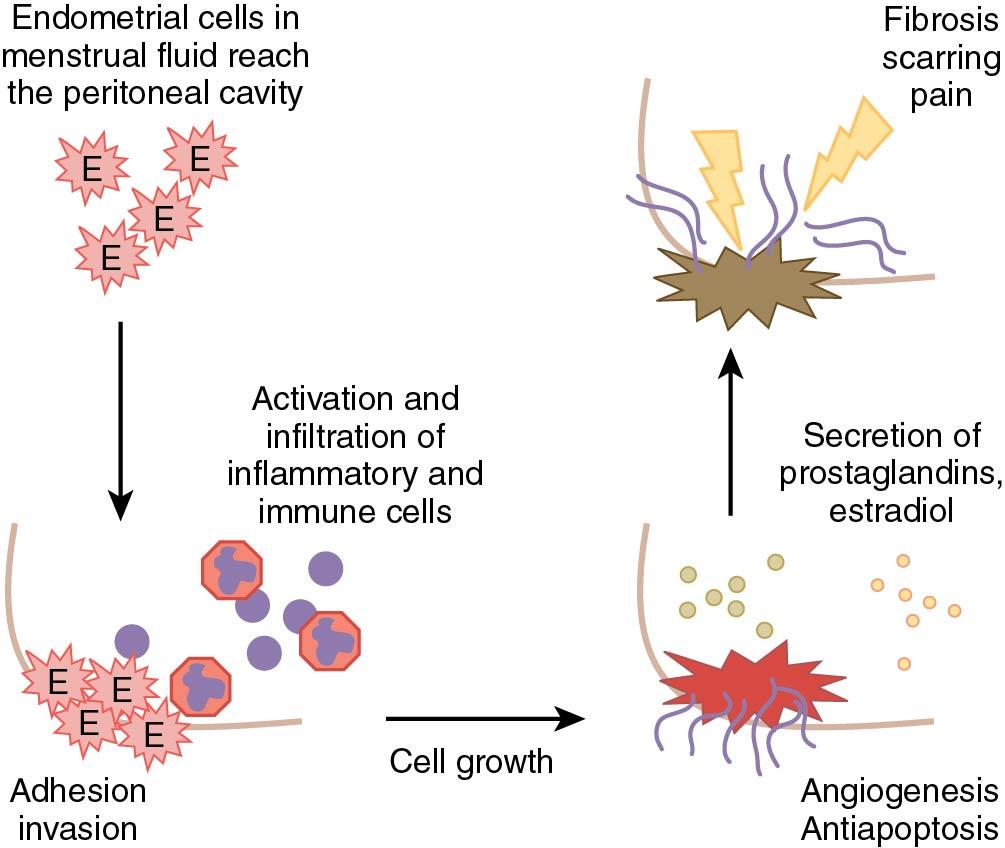
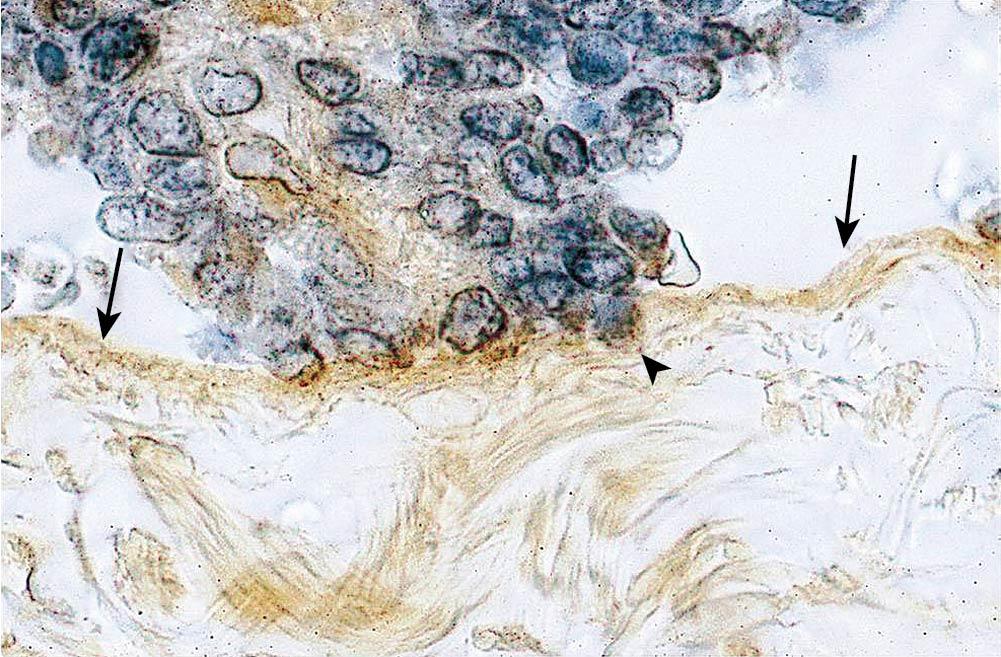
In contrast to the theory of seeding from retrograde menstruation is the theory that endometriosis arises from metaplasia of the coelomic epithelium or proliferation of embryonic rests. The müllerian ducts and nearby mesenchymal tissue form the majority of the female reproductive tract. The müllerian duct is derived from the coelomic epithelium during fetal development. The metaplasia hypothesis postulates that the coelomic epithelium retains the ability for multipotential development. The decidual reaction of isolated areas of peritoneum during pregnancy is an example of this process. It is well known that the surface epithelium of the ovary can differentiate into several different histologic cell types. Endometriosis has been discovered in prepubertal girls, women with congenital absence of the uterus, and, rarely, in men. These examples support the coelomic metaplasia theory.
Metaplasia occurs after an “induction phenomenon” has stimulated the multipotential cell. The induction substance may be a combination of menstrual debris and the influence of estrogen and progesterone. It has been hypothesized that the histogenesis of endometriosis in peritoneal pockets of the posterior pelvis results from a congenital anomaly involving rudimentary duplication of the müllerian system ( ). The peritoneal pockets that they describe are found in the posterior pelvis, the posterior aspects of the broad ligament, and the cul-de-sac ( Fig. 19.3 ). Similarly, it has been postulated that metaplasia of the coelomic epithelium that invaginates into the ovarian cortex is the pathogenesis for the development of ovarian endometriosis ( ).
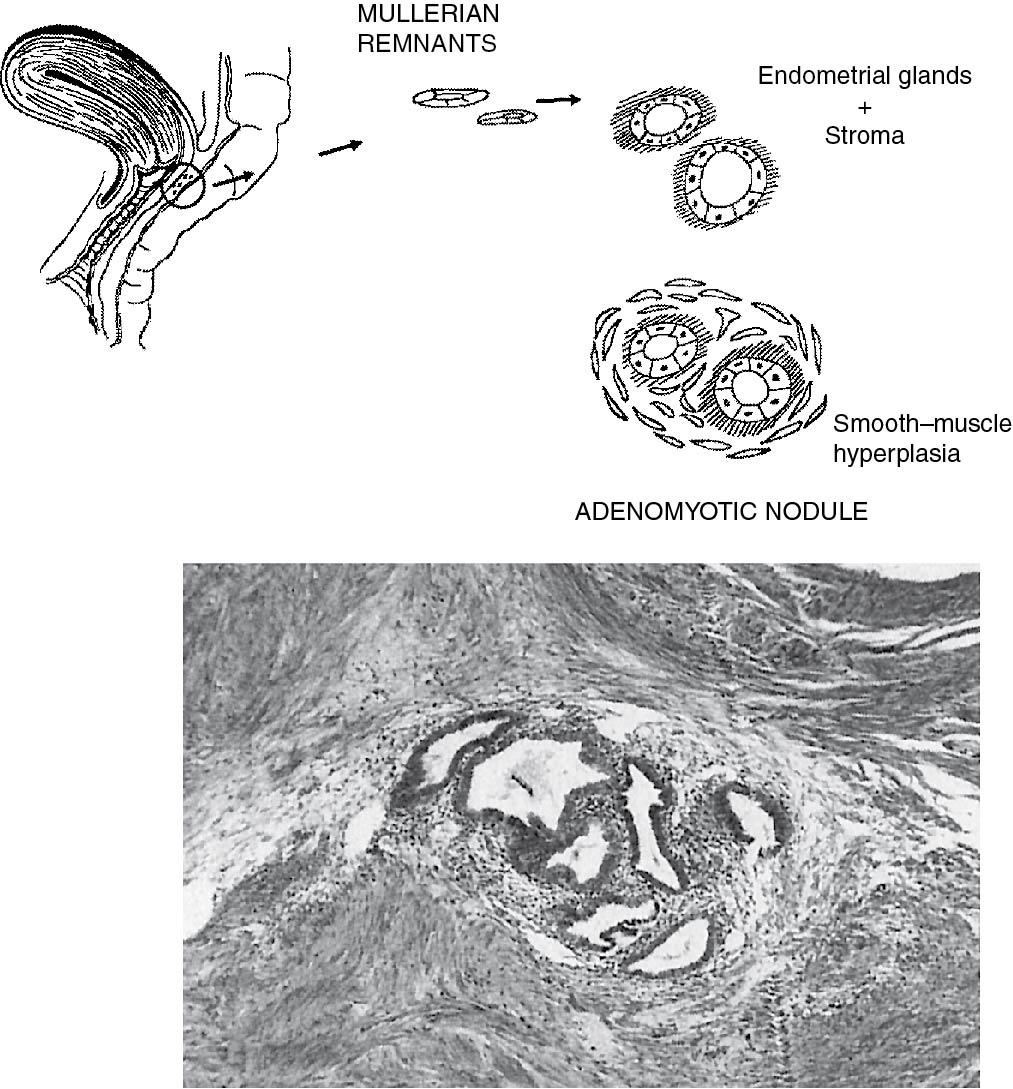
The theory of endometrium being transplanted via lymphatic channels and the vascular system helps to explain rare and remote sites of endometriosis, such as the spinal column and nose. Endometriosis has been observed in the pelvic lymph nodes of approximately 30% of women with the disease. Hematogenous dissemination of endometrium is the best theory to explain endometriosis of the forearm and thigh, as well as multiple lesions in the lung.
Endometriosis of the anterior abdominal wall is sometimes discovered in women after a cesarean delivery. The hypothesis is that endometrial glands and stroma are implanted during the procedure. The aberrant tissue is found subcutaneously at the abdominal incision. Rarely, iatrogenic endometriosis may be discovered in an episiotomy scar.
One of the most perplexing, unanswered questions concerning the pathophysiology of endometriosis is that some women with retrograde menstruation develop endometriosis, but most do not. Multiple investigations have suggested that changes in the immune system, especially altered function of immune-related cells, are directly related to the pathogenesis of endometriosis . Whether endometriosis is an autoimmune disease has been intensely debated for many years. Studies have demonstrated abnormalities in cell-mediated and humoral components of the immune system in both peripheral blood and peritoneal fluid. Box 19.1 depicts various cytokines and growth factors that have been implicated in the pathogenesis of endometriosis ( ).
Complement
Eotaxin
Glycodelin
IL-1
IL-6
IL-8
MCP-1
PDGF
RANTES
Soluble ICAM-1
TGF-β
VEGF
EGF
Basic FGF
Interferon-γ
IL-2
IL-4
IL-12
IL-13
EGF, Epidermal growth factor; FGF, fibroblast growth factor; ICAM, intercellular adhesion molecule; IL, interleukin; MCP, membrane cofactor protein; PDGF, platelet-derived growth factor; RANTES, regulated on activation, normal T cell expressed and secreted; TGF, transforming growth factor; VEGF, vascular endothelial growth factor. References are from the original source.
Most likely the primary immunologic change involves an alteration in the function of the peritoneal macrophages so prevalent in the peritoneal fluid of patients with endometriosis. It has been hypothesized that women who do not develop endometriosis have monocytic-type macrophages in their peritoneal fluid that have a short life span and limited function. Conversely, women who develop endometriosis have more peritoneal macrophages that are larger. These hyperactive cells secrete multiple growth factors and cytokines that enhance the development of endometriosis. The attraction of leukocytes to specific areas is controlled by chemokines, which are chemotactic cytokines. Changes in the expression of integrins also may be an important local factor. Following the theory of different macrophage populations in endometriosis is the finding that the destroying of normally extruded endometrial cells in endometriosis may be deficient. It has been shown that natural killer (NK) cells have decreased cytotoxicity against endometrial and hematopoietic cells in women with endometriosis. Also, peritoneal fluid of women with endometriosis has less influence of NK activity than is found in fertile women without endometriosis .
Another attractive theory is the finding of a protein similar to haptoglobin in endometriosis epithelial cells called endo-1. This chemoattractant protein–enhanced local production of interleukin-6 (IL-6) self-perpetuates lesion/cytokine interactions. Further compounding the proliferative activity of endometriosis lesions are angiogenic factors that are increased in lesions. Here the expression of basic fibroblast factor, IL-6, IL-8, platelet-derived growth factor (PDGF), and vascular endothelial growth factor (VEGF) are all increased (see Box 19.1 ).
Steroid interactions also enhance the progression of disease. Estrogen production is enhanced locally, and there is evidence for upregulation of aromatase activity , increased cyclooxygenase-2 (COX-2) expression, and dysregulation of 17β-dehydrogenase activity, where there is a deficiency in 17β-dehydrogenase II activity and possibly an enhancement of type II activity favoring local estradiol production ( ). Fig. 19.4 shows abnormalities of COX-2, aromatase, and 17β-hydroxysteroid dehydrogenase type 2 (HSD17B2) in disease-free women, and endometrium and ectopic lesions in women with endometriosis where high local concentrations of estrogen and prostaglandin E 2 predominate ( Fig. 19.5 ). Enhanced aromatase activity appears to be the result of overexpression of the orphan nuclear receptor steroidogenic factor-1 (SF-1) in lesions. The local production of estrogen through aromatase activity explains why progression of lesions may occur even with ovarian suppression. Further, there is evidence for progesterone “resistance” ( ) ( Fig. 19.6 ). This is occasioned by a dysregulation of the isoform B of the progesterone receptor in most endometriotic lesions, where levels may be undetectable. The latter propensity may be on a genetic basis, as discussed later.
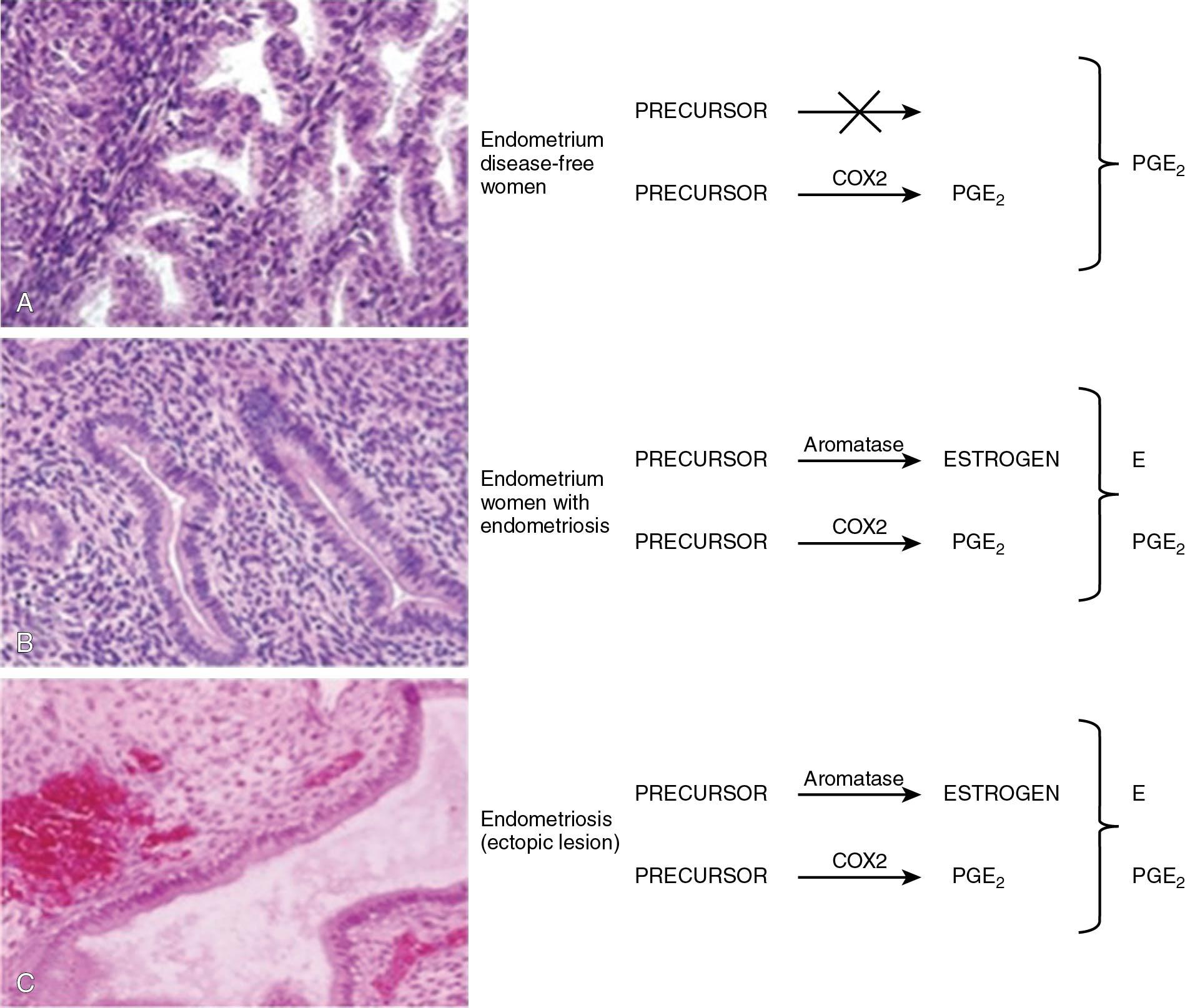
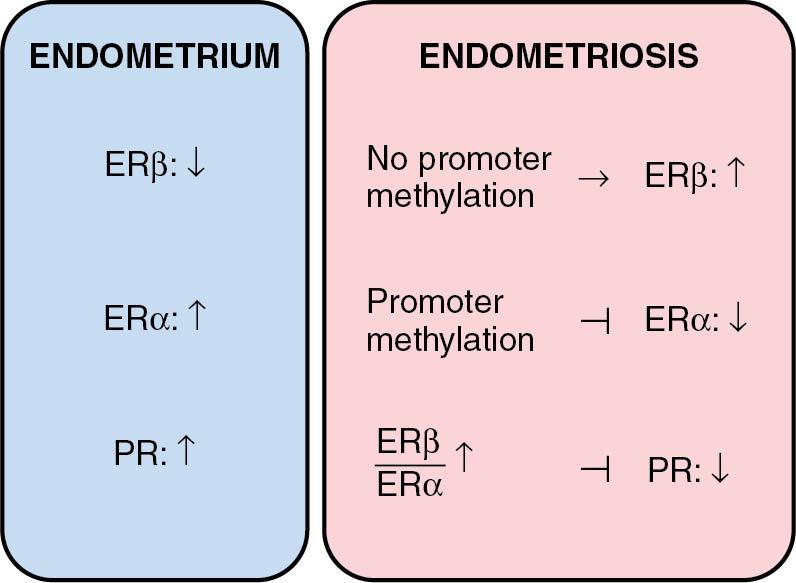
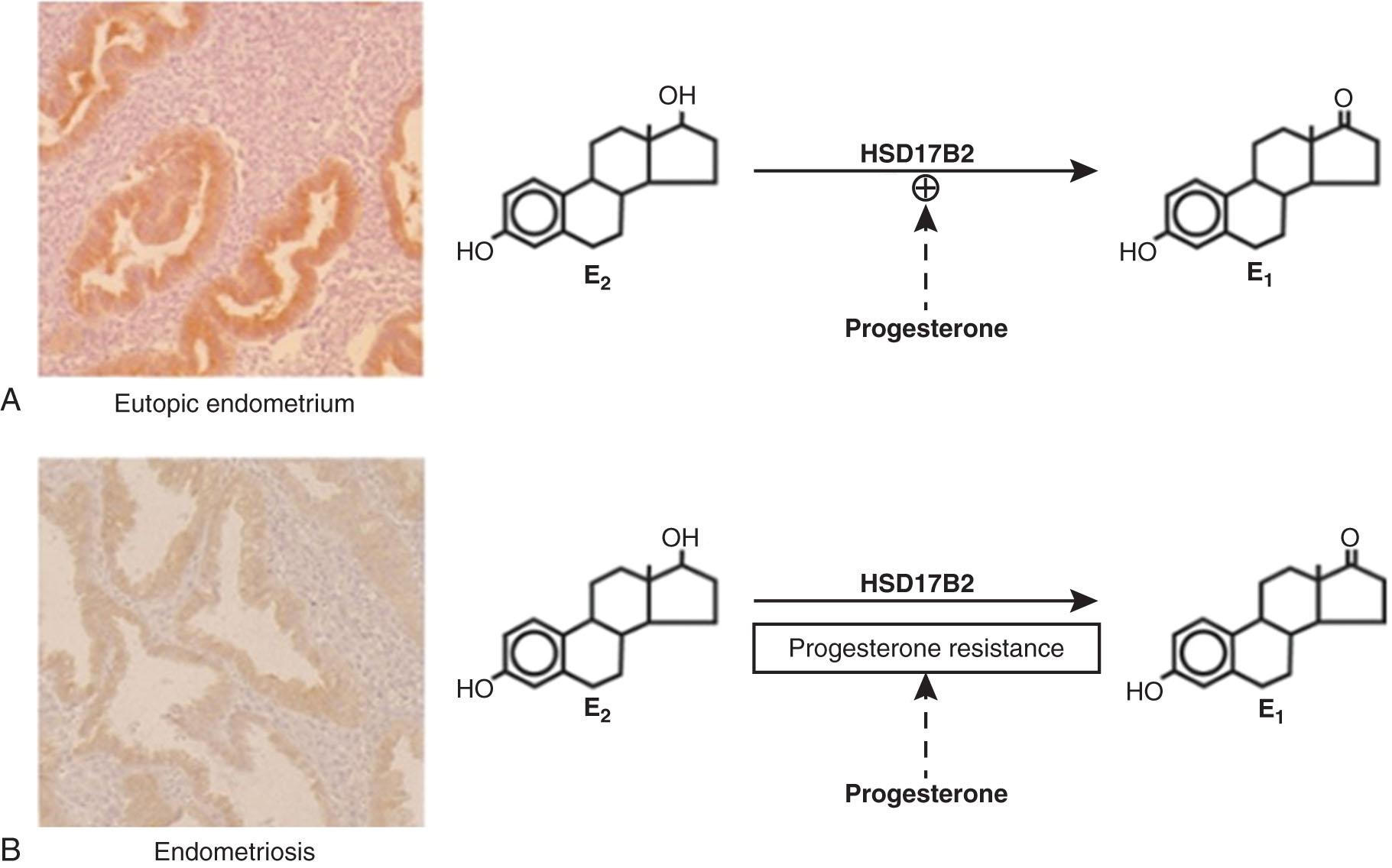
Autoimmunity may well exist in women with endometriosis , and although the findings of abnormalities of the histocompatibility locus antigen system have not been consistent, there are reports of increased B and T cells and serum immunoglobulin (IgG, IgA, and IgM) autoantibodies in endometriosis. A survey from the U.S. Endometriosis Association has provided suggestive evidence of the higher prevalence of other autoimmune diseases . The association of all these immune processes in the symptoms and signs of endometriosis is depicted in Fig. 19.7 .
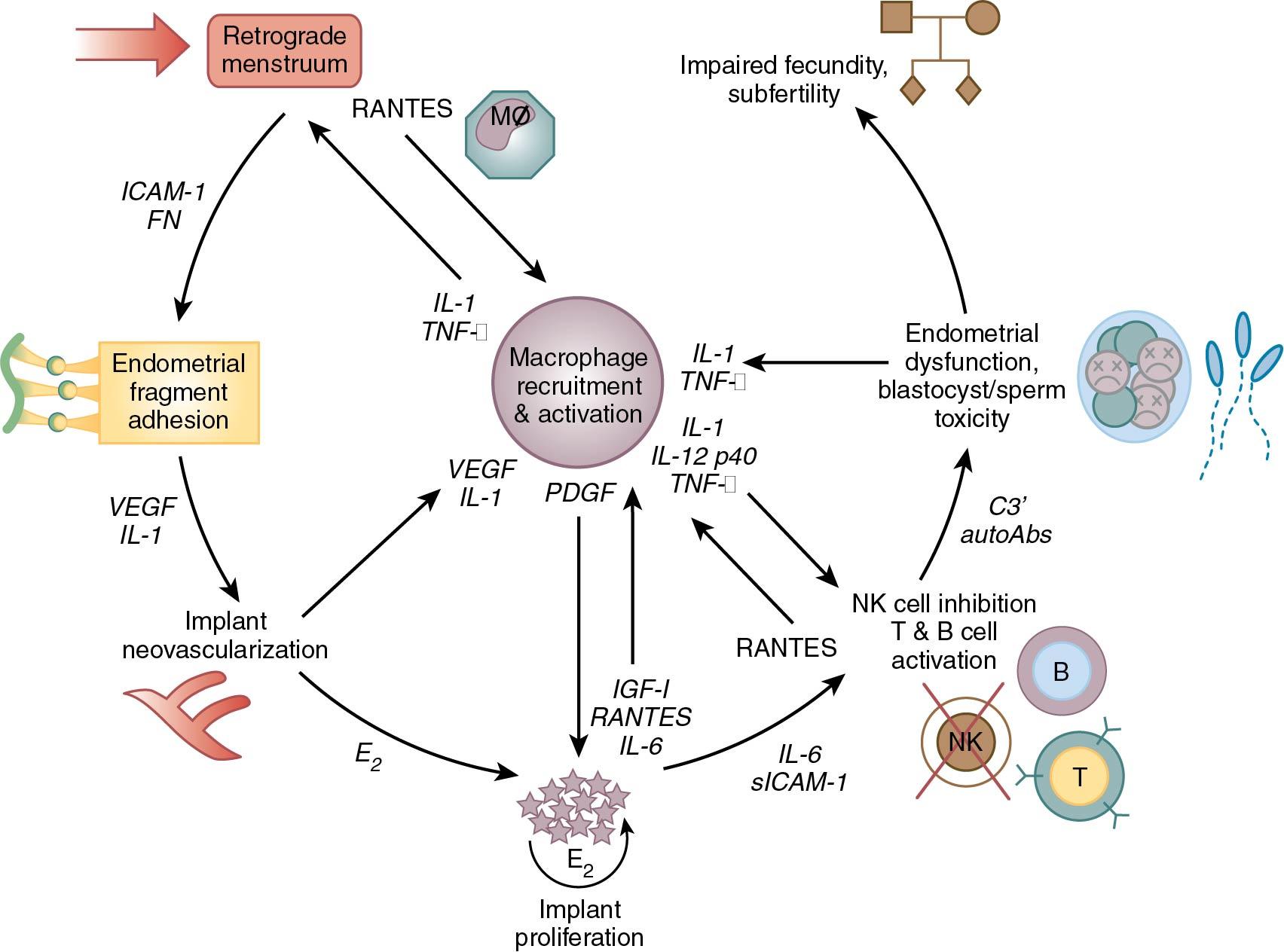
Several studies have documented a familial predisposition to endometriosis with grouping of cases of endometriosis in mothers and their daughters. An investigation by Simpson and coworkers demonstrated a sevenfold increase in the incidence of endometriosis in relatives of women with the disease compared with controls ( ). One of 10 women with severe endometriosis will have a sister or mother with clinical manifestations of the disease. The genetic heritability of endometriosis has been estimated at 52% based on twin studies ( ). Women who have a family history of endometriosis are likely to develop the disease earlier in life and to have more advanced disease than women whose first-degree relatives are free of the disease.
Endometriosis is clearly not a single-gene disease but rather polygenic, with various susceptibility factors discovered. Studies have identified deletions of genes, most specifically increased heterogenicity of chromosome 17 and aneuploidy, in women with endometriosis compared with controls ( ). Loci on 7p and 10q have also been found to increase the susceptibility for endometriosis. The expression of this genetic liability most likely depends on an interaction with environmental and epigenetic factors , with many factors being involved.
Epigenetic factors play a significant role and may be influenced by environmental factors ( ). The epigenetics involves hypomethylation of genes and may help explain, for example, the increased expression of SP1 leading to increased estrogen receptor (ER)β over ERα, which in turn leads to progesterone resistance in endometriosis.
Preliminary data suggest some bilateral ovarian endometrial cysts may arise independently from different clones. Although no consistent abnormality has been found in women with endometriosis, there are several candidate genes. Box 19.2 provides a partial list of genes and gene products aberrantly expressed in endometriosis.
Aromatase
Endometrial bleeding factor
Hepatocyte growth factor
17β-hydroxysteroid dehydrogenase
HOX A10
HOX A11
Leukemia inhibitory factor
Matrix metalloproteinases 3, 7, and 11
Tissue inhibitors of metalloproteinases
Progesterone-receptor isoforms
Complement 3
Glutathione peroxidase
Catalase
Thrombospondin 1
Vascular endothelial growth factor
Integrin α v β 3
Glycodelin
Several of these aberrantly expressed gene products, such as the matrix metalloproteinases (MMPs) and integrins, have important implications for endometrial lesion attachment and for implantation defects, which may exist in infertile women with endometriosis. Reflux of MMPs into the peritoneal cavity at menstruation may contribute to peritoneal attachment in susceptible women.
MicroRNAs have also been found to be involved (particularly the 9 and 34 families) and may be implicated in the pathogenesis as well. Also, the measurement of certain microRNAs has been suggested as a test for endometriosis, although there are no data to support this.
Certain ethnic groups have an increased risk of endometriosis. This is particularly striking in Asian women, in whom a ninefold increase has been suggested.
The majority of endometrial implants are located in the dependent portions of the female pelvis ( Fig. 19.8 ). The ovaries are the most common site, being involved in two of three women with endometriosis. In most of these women the involvement is bilateral. The pelvic peritoneum over the uterus; the anterior and posterior cul-de-sac; and the uterosacral, round, and broad ligaments are also common sites where endometriosis develops. Pelvic lymph nodes have been found to be involved in up to 30% of cases.
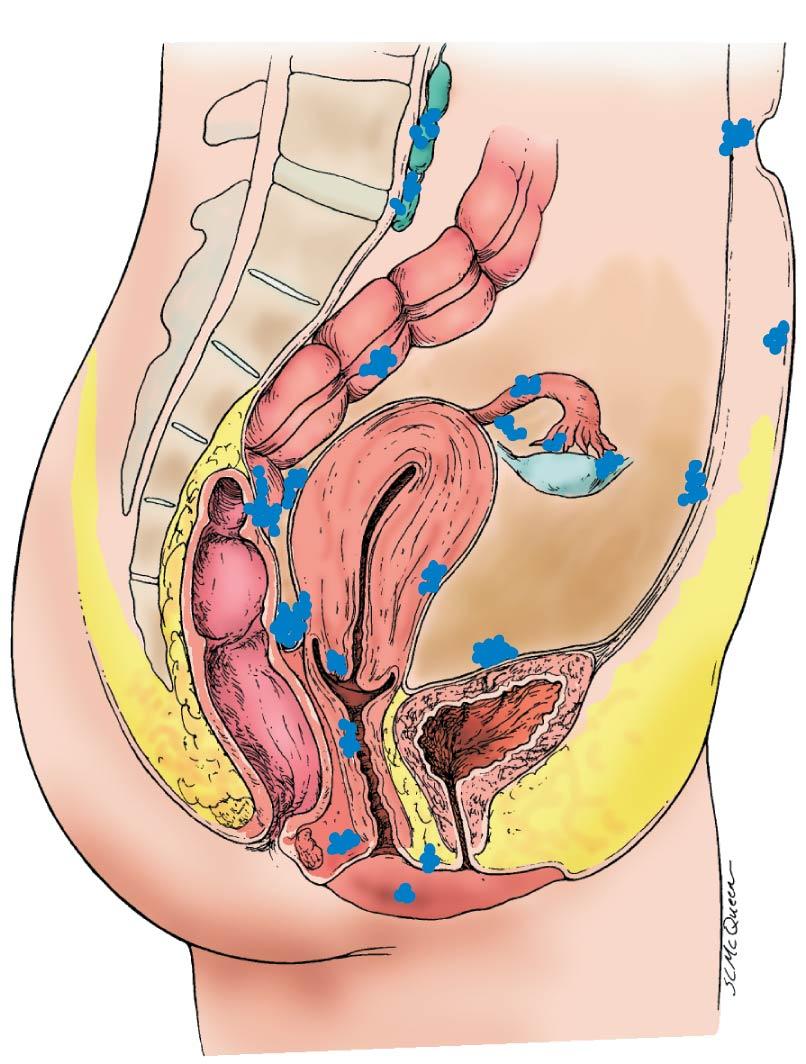
The cervix, vagina, and vulva are other possible pelvic locations. Brosens has emphasized the importance of distinguishing between superficial and deep lesions of endometriosis ( ). Deep lesions, penetrations of greater than 5 mm, represent a more progressive form of the disease. Distinguishing superficial implant lesions on peritoneal surfaces, including the ovary, from deep endometriotic ovarian cysts and cul-de-sac nodules is important for therapy because the latter abnormalities may suggest different causes of the disease (e.g., metaplasia), which require a surgical approach.
Approximately 10% to 15% of women with advanced disease have lesions involving the rectosigmoid. Depending on the amount of associated scarring, endometriosis of the bowel may be difficult to differentiate grossly from a primary neoplasm of the large intestine. Endometriosis may be found in a wide variety of sites, including the umbilicus, areas of previous surgical incisions of the anterior abdominal wall or perineum, the bladder, ureter, kidney, lung, arms, legs, and even the male urinary tract ( Table 19.1 ).
| Common Sites | Rare Sites |
|---|---|
| Ovaries | Umbilicus |
| Pelvic peritoneum | Episiotomy scar |
| Ligaments of the uterus | Bladder |
| Sigmoid colon | Kidney |
| Appendix | Lungs |
| Pelvic lymph nodes | Arms |
| Cervix | Legs |
| Vagina | Nasal mucosa |
| Fallopian tubes | Spinal column |
Gross pathologic changes of endometriosis exhibit wide variability in color, shape, size, and associated inflammatory and fibrotic changes. The visual manifestations of endometriosis in the female pelvis are protean and have many appearances. Increased awareness and anticipation have focused on the subtle lesions of endometriosis. Clinicians closely inspect the pelvic peritoneum to identify abnormal areas and small, nonhemorrhagic lesions. More emphasis has been placed on biopsy confirmation of endometriosis because of increasing awareness of subtle lesions. The gross appearance of the implant depends on the site, activity, relationship to the day of the menstrual cycle, and chronicity of the area involved. The color of the lesion varies widely and may be red, brown, black, white, yellow, pink, clear, or a red vesicle. The predominant color depends on the blood supply and the amount of hemorrhage and fibrosis. The color also appears related to the size of the lesion, the degree of edema, and the amount of inspissated material ( Table 19.2 ). Fig. 19.9 depicts the spectrum of lesions with black and white lesions reflecting older lesions with inflammatory and fibrotic changes. Other peritoneal lesions that grossly appear similar to endometriosis, but on histologic examination are not, include necrotic areas of an ectopic pregnancy, fibrotic reactions to suture, hemangiomas, adrenal rest, Walthard rest, breast cancer, ovarian cancer, epithelial inclusions, residual carbon from laser surgery, peritoneal inflammation, psammoma bodies, peritoneal reactions to oil-based hysterosalpingogram dye, and splenosis.
| Symptom | No. of Patients | (%) |
|---|---|---|
| Pelvic pain | 111 | (85) |
| Rectal pain | 68 | (52) |
| Cyclic rectal bleeding | 24 | (18) |
| Diarrhea | 55 | (42) |
| Constipation | 53 | (41) |
| Diarrhea and constipation | 18 | (14) |
| Dyspareunia | 83 | (64) |
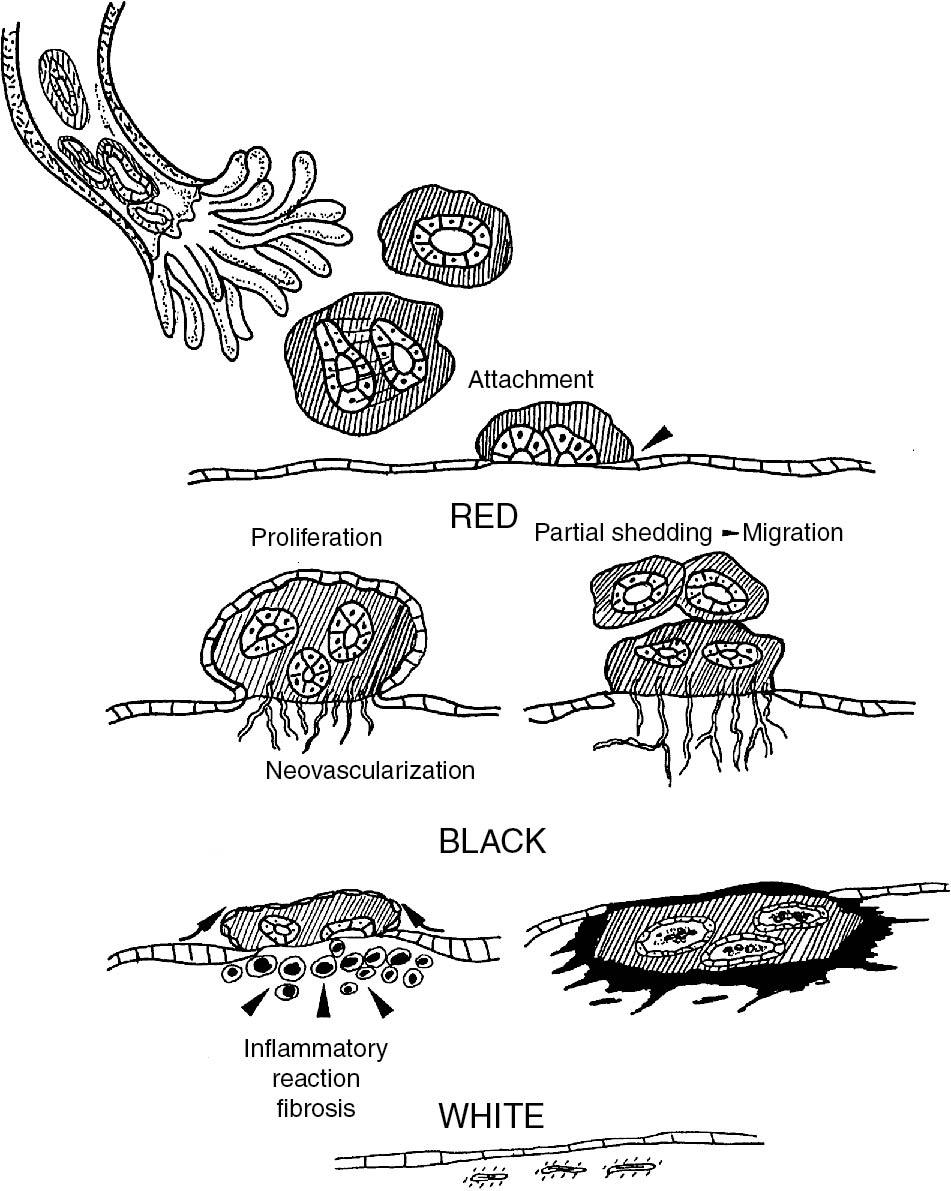
New lesions are small, bleblike implants that are less than 1 cm in diameter. Initially these areas are raised above the surrounding tissues. Red, blood-filled lesions have been shown, by histologic and biochemical studies, to be the most active phase of the disease ( Fig. 19.9 ). With time, the areas of endometriosis become larger and assume a light or dark brown color, and they may be described as “powder burn” areas or “chocolate cysts.” The older lesions are white, have more intense scarring, and are usually puckered or retracted from the surrounding tissue. White or mixed-colored lesions are more likely to provide histologic confirmation of endometriosis. Also, the progression from red to white lesions also seems to correlate with age.
The pattern of ovarian endometriosis is also variable. Individual areas range from 1 mm to large chocolate cysts greater than 8 cm in diameter ( Fig. 19.10 ). The associated adhesions may be filmy or dense, and larger cysts are usually densely adherent to the surrounding pelvic sidewalls or broad ligament.
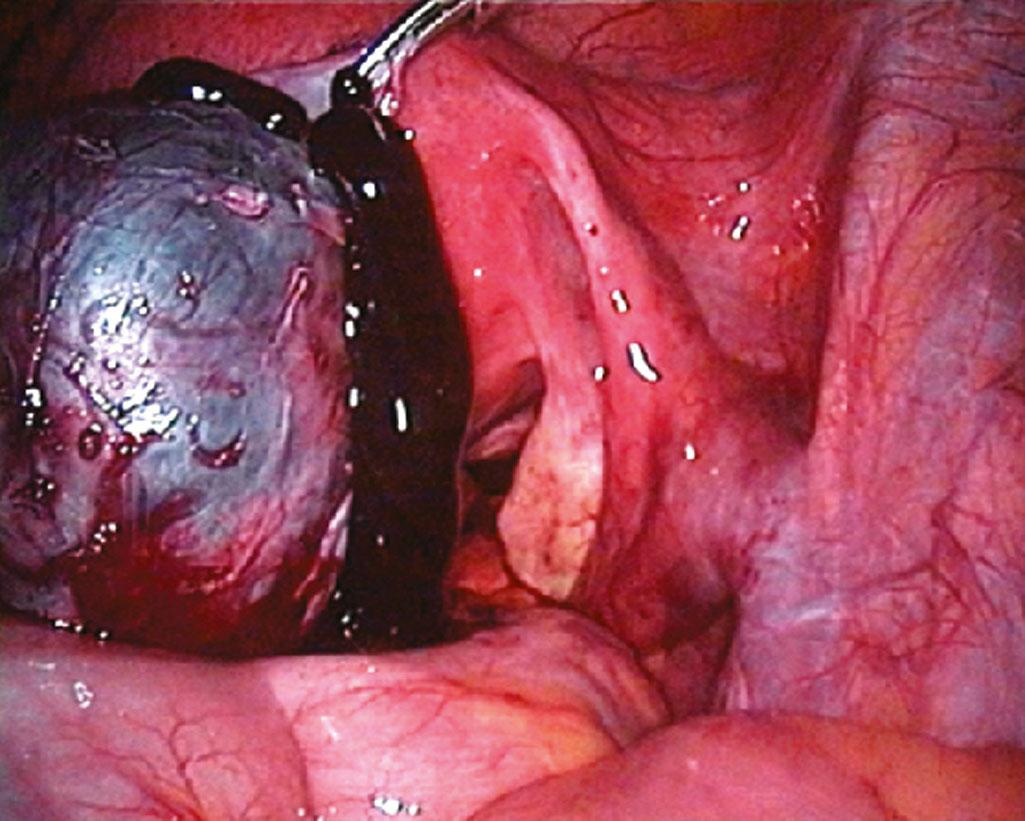
The three cardinal histologic features of endometriosis are ectopic endometrial glands, ectopic endometrial stroma, and hemorrhage into the adjacent tissue ( Fig. 19.11 ). Previous hemorrhage can be discovered by identifying large macrophages filled with hemosiderin near the periphery of the lesion. In the majority of cases, the aberrant endometrial glands and stroma respond in cyclic fashion to estrogen and progesterone. These changes may or may not be in synchrony with the endometrial lining of the uterus. The ectopic endometrial stroma will undergo classic decidual changes similar to pregnancy when exposed to high physiologic or pharmacologic levels of progesterone.
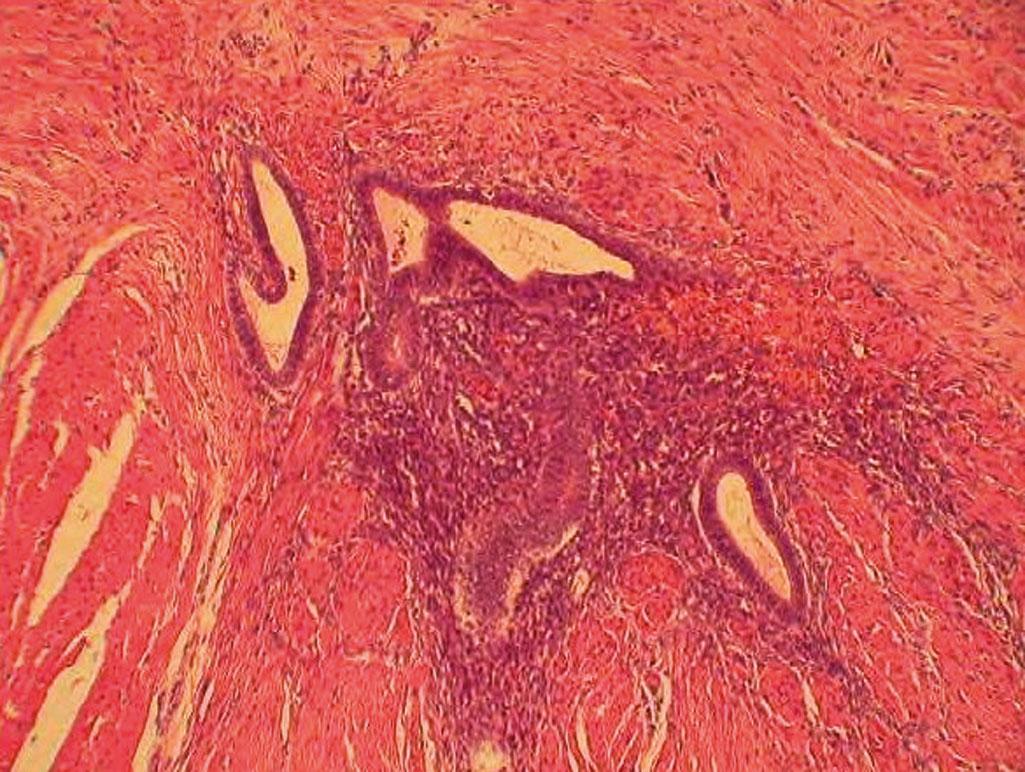
In approximately 25% of cases of endometriosis, viable endometrial glands and stroma cannot be identified . Repetitive episodes of hemorrhage may lead to severe inflammatory changes and result in the glands and stroma undergoing necrobiosis secondary to pressure atrophy or lack of blood supply. In these cases a presumptive diagnosis of endometriosis is made by visualizing the intense inflammatory reaction and the large macrophages filled with blood pigment.
The natural history of endometriosis has been discussed, and although clinicians usually think of endometriosis as a progressive disease, this is not always the case; it has been shown to be progressive only about one-third of the time. The pathophysiology of progression from subtle endometriosis to severe disease may be expected from the multiple mechanisms of potential disease acceleration discussed earlier, with immune function most likely involved.
Become a Clinical Tree membership for Full access and enjoy Unlimited articles
If you are a member. Log in here